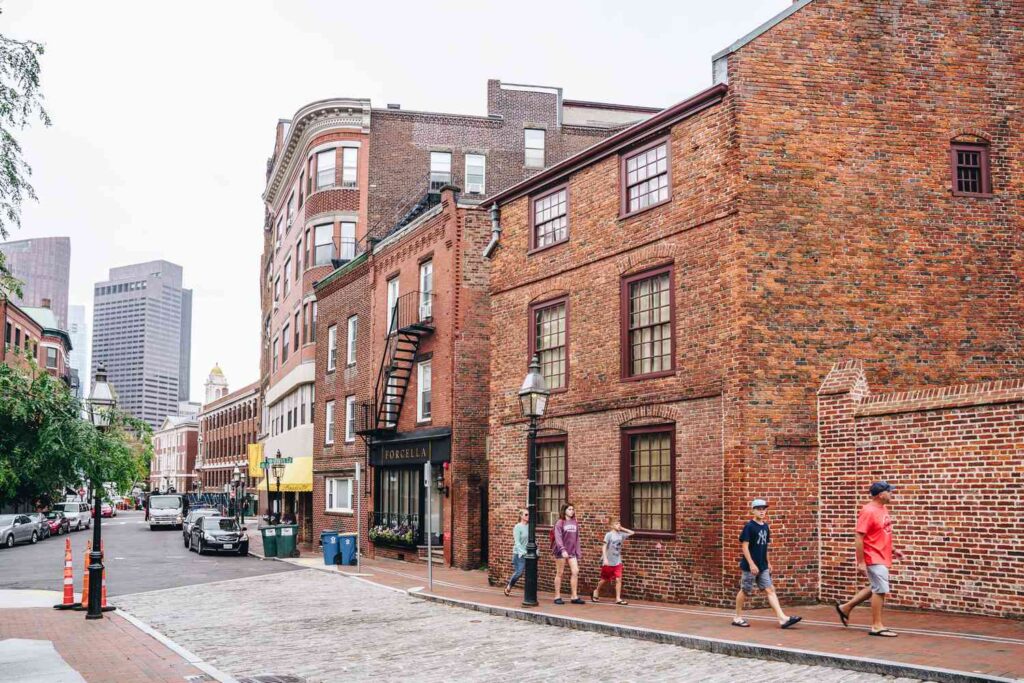
El famoso Freedom Trail es un sendero de ladrillos rojos de 2,5 millas que atraviesa los barrios históricos de Boston y que cuenta la historia de la Revolución Americana y más allá. Desde la Old North Church hasta Faneuil Hall, y a través de resonantes cementerios, visite los templos y lugares emblemáticos de la era revolucionaria.
Sitios del sendero de la libertad
Comience su viaje en el Centro de información para visitantes de Boston Common ubicado en 139 Tremont Street y concluya en el USS Constitution en Charlestown.
BOSTON COMMON
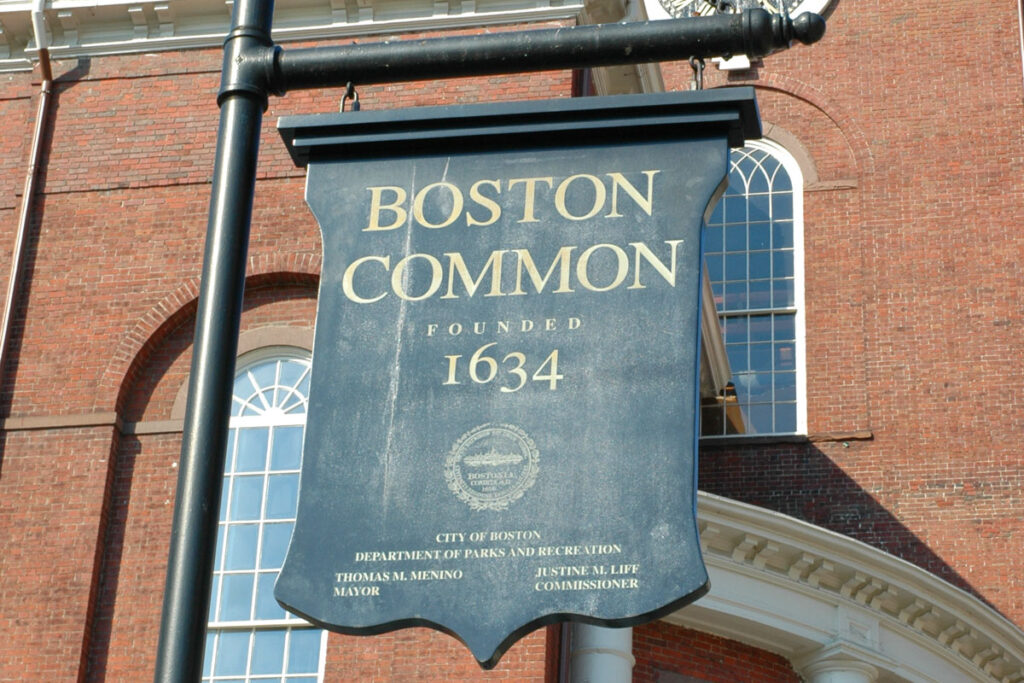
El Boston Common es el parque público más antiguo de Estados Unidos, adquirido a Wm. Blackstone en 1635 para ser utilizado como tierra de pastoreo común para la alimentación del ganado. La milicia británica lo utilizó como campo de entrenamiento.
El Common también ha sido escenario de ahorcamientos, duelos, celebraciones públicas y animada oratoria. Hoy en día sigue albergando celebraciones públicas, así como conciertos, patinaje sobre hielo, obras de Shakespeare, festividades navideñas, actividades deportivas y mítines públicos.
CASA DEL ESTADO DE MASSACHUSETTS
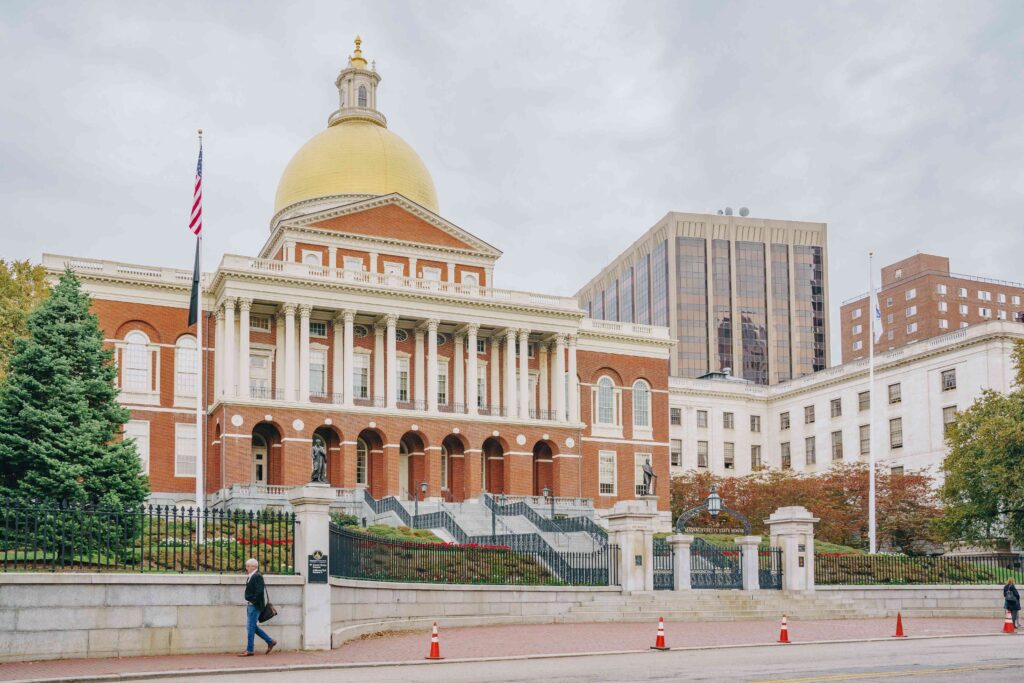
Diseñada por Charles Bulfinch, la Casa del Estado se completó en enero de 1798 a un costo de 133.333 dólares (más de cinco veces el presupuesto). John Hancock, un rico comerciante, patriota, firmante de la Declaración de Independencia y primer gobernador electo de Massachusetts, originalmente era dueño de la tierra. El edificio más antiguo de Beacon Hill es ahora la sede del gobierno del estado de Massachusetts. La cúpula dorada, uno de los hitos distintivos de Boston, no siempre fue dorada. Originalmente fue construido en madera. Paul Revere & Sons recibió el encargo en 1802 de cubrirlo con cobre para evitar fugas de agua. En 1874, la cúpula fue dorada con pan de oro de 23 quilates.
IGLESIA DE LA CALLE DEL PARQUE
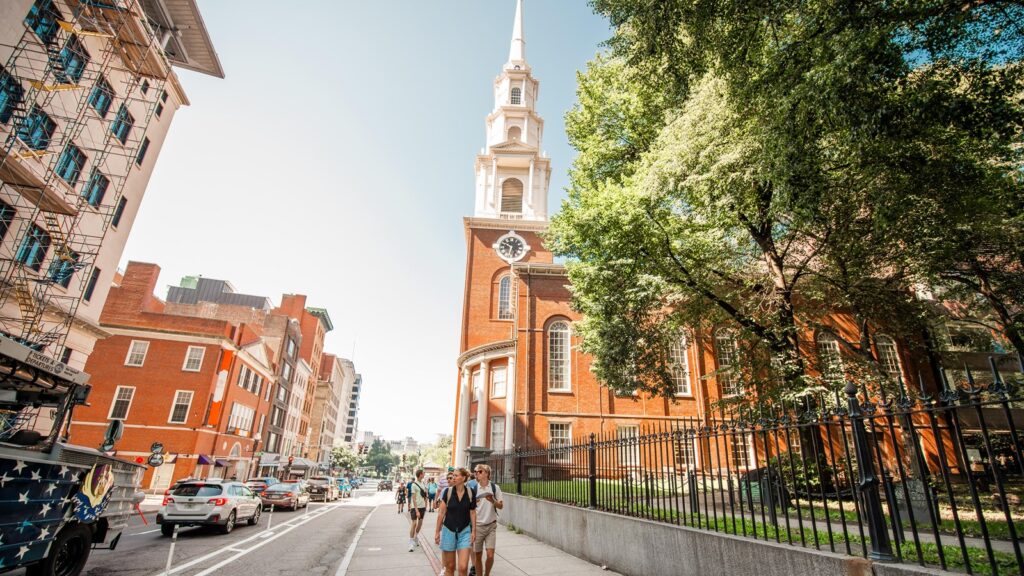
Park Street Church adquirió el sobrenombre de Brimstone Corner, tanto en referencia a los sermones de fuego y azufre como a la pólvora que se almacenó en la cripta durante la Guerra de 1812. Fundada en 1809, el campanario blanco de 217 pies de la iglesia era el Primer hito que vio un viajero al acercarse a Boston.
El 4 de julio de 1829, el abolicionista William Lloyd Garrison pronunció aquí su primer discurso público contra la esclavitud, y dos años más tarde, el 4 de julio, se cantó por primera vez en las escaleras de la Iglesia el himno América, más conocido como My Country ‘Tis of Thee. .
CEMENTERIO DEL GRANARIO
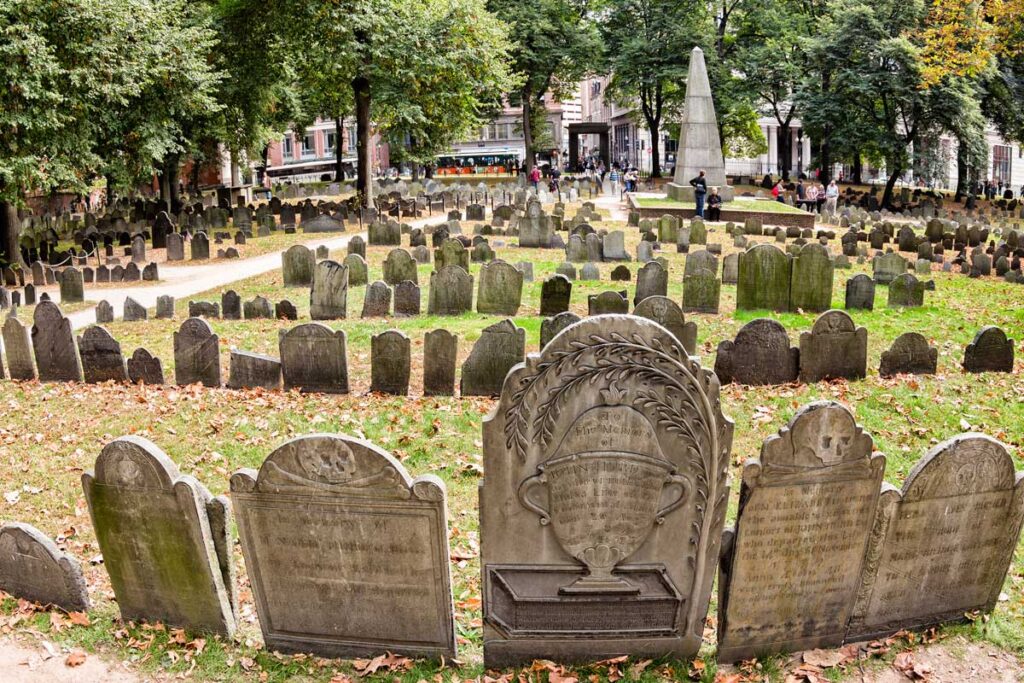
Llamado así debido a su proximidad al primer granero de Boston, este es el cementerio más visitado de Boston y el lugar de descanso final de muchos bostonianos prominentes. Aquí están enterrados John Hancock, Samuel Adams, nueve gobernadores, las cinco víctimas de la masacre de Boston, Paul Revere, los padres de Ben Franklin y Peter Faneuil.
CAPILLA DEL REY Y CEMENTERIO
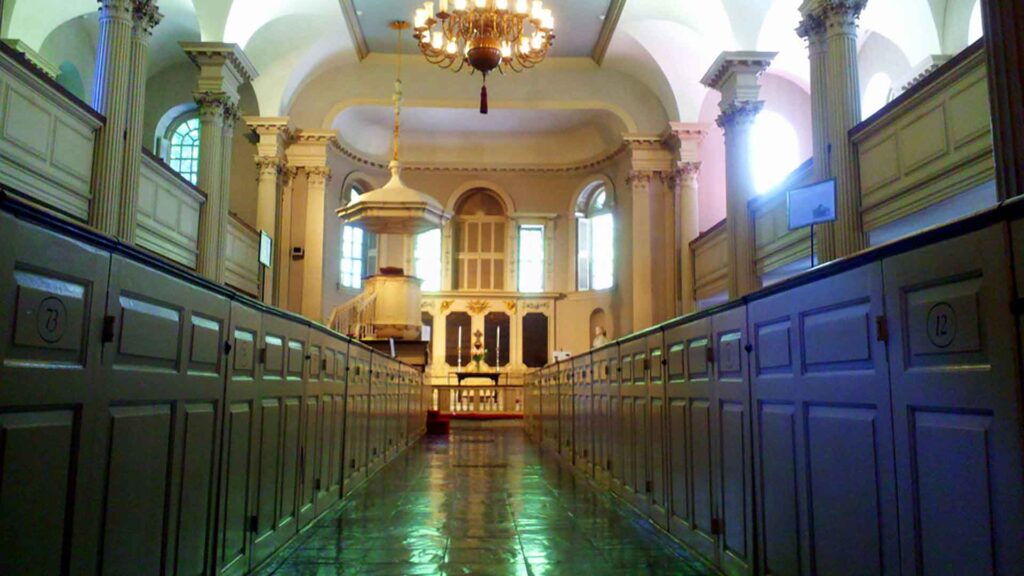
Por orden del rey Jaime II en 1686, se confiscaron tierras y se construyó la primera iglesia anglicana. En 1749, la estructura de madera original era demasiado pequeña para la congregación, por lo que se construyó la capilla georgiana alrededor de la iglesia original.
Junto a King’s Chapel se encuentra el primer cementerio de Boston. Aquí encontrará las tumbas de John Winthrop, el primer gobernador de Massachusetts; William Dawes, compatriota de Paul Revere que también viajó a Lexington, y Mary Chilton, que se cree que fue la primera mujer en bajarse del Mayflower.
SITIO DE LA ESCUELA LATINA DE BOSTON/ESTATUA DE BENJAMIN FRANKLIN
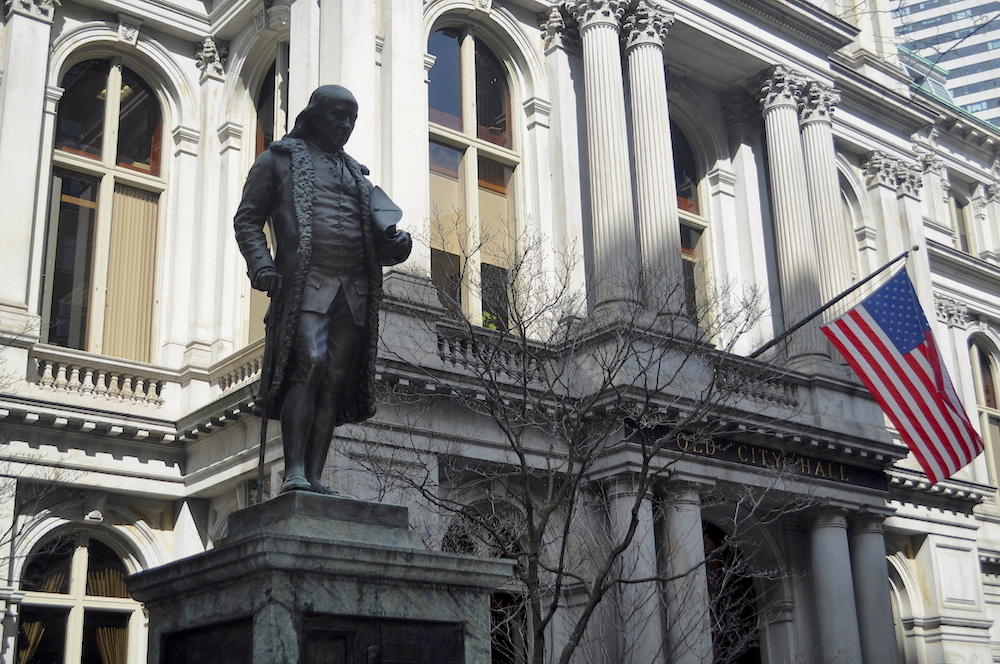
Incrustado en la acera frente al Antiguo Ayuntamiento se encuentra el mosaico City Carpet, que conmemora el sitio de la primera escuela pública en los EE. UU., Boston Latin School (1635). Entre los alumnos de la escuela se encuentran Ben Franklin, John Hancock, Samuel Adams, Charles Bulfinch y Ralph Waldo Emerson.
La estatua de Ben Franklin de Richard Greenough, erigida en 1856, se encuentra en un lugar destacado frente al antiguo ayuntamiento. Mire de cerca el rostro de Franklin. El escultor dijo que encontraba el lado izquierdo del rostro del gran hombre filosófico y reflexivo y el lado derecho divertido y sonriente.
ANTIGUA LIBRERÍA DE LA ESQUINA
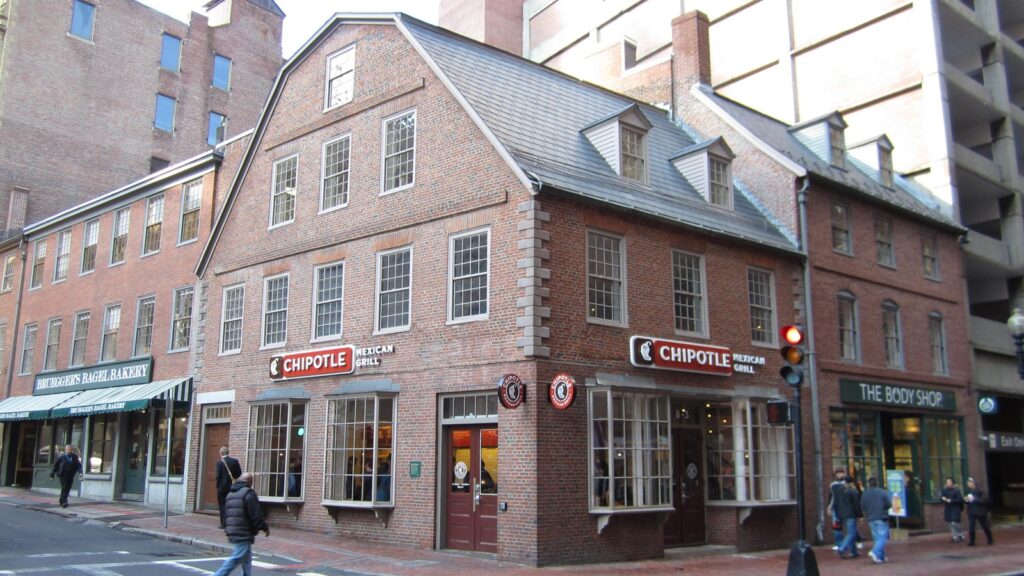
El edificio original en este sitio fue la casa de Anne Hutchinson, quien fue desterrada de Massachusetts en 1638 por sus opiniones religiosas poco ortodoxas. A mediados del siglo XIX, la librería Old Corner era un floreciente centro literario. Aquí, Ticknor y Fields publicaron obras de Dickens, Harriet Beecher Stowe, Tennyson, Hawthorne, Emerson, Longfellow, Oliver Wendell Holmes, Elizabeth Barrett Browning y Julia Ward Howe, entre otros. El Atlantic Monthly, una institución de Boston, también se publicó originalmente aquí. Hoy, el edificio continúa como un lugar de comercio.
ANTIGUA CASA DE REUNIONES DEL SUR
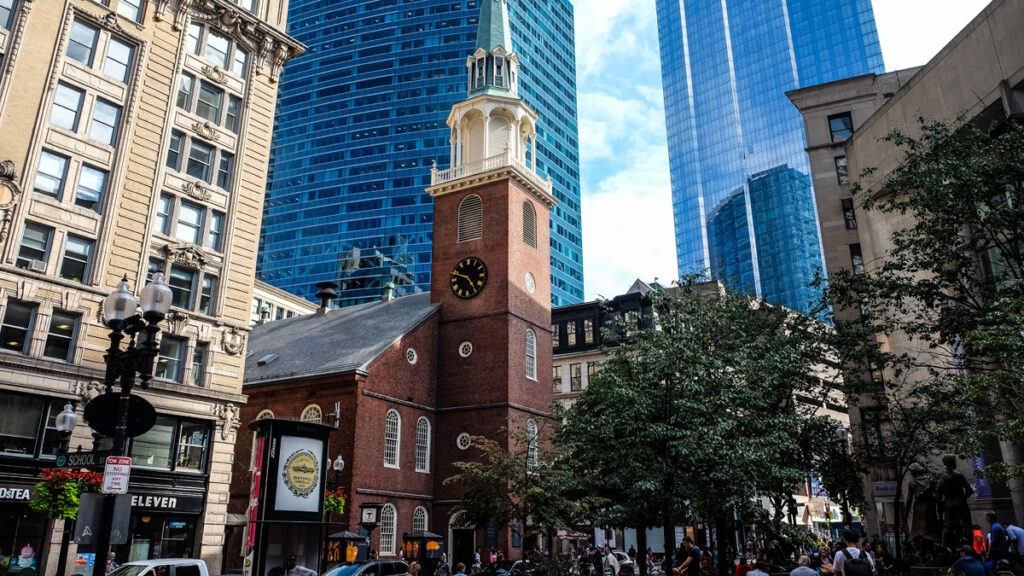
Construida en 1729, esta es la segunda iglesia más antigua de Boston. El edificio más grande del Boston colonial, Old South, se utilizó para reuniones públicas cuando la multitud enojada superó al Faneuil Hall. Muchos de los acontecimientos cruciales que condujeron a la Revolución tuvieron lugar aquí. La más famosa de las reuniones se celebró el 16 de diciembre de 1773, cuando más de 5.000 personas se reunieron para protestar contra el impuesto al té.
Durante la ocupación británica de Boston en 1775-1776, las tropas británicas profanaron este santuario de libertad usándolo como establo y escuela de equitación, mientras se servían bebidas desde el balcón. El púlpito y los bancos se cortaron para convertirlos en leña y la biblioteca se utilizó como leña.
Por otra parte, Phillis Wheatley, la primera poeta afroamericana publicada, era miembro de pleno derecho de Meeting House. Aquí se exhibe permanentemente una copia original de su obra.
MUSEO DE LA ANTIGUA CASA ESTATAL
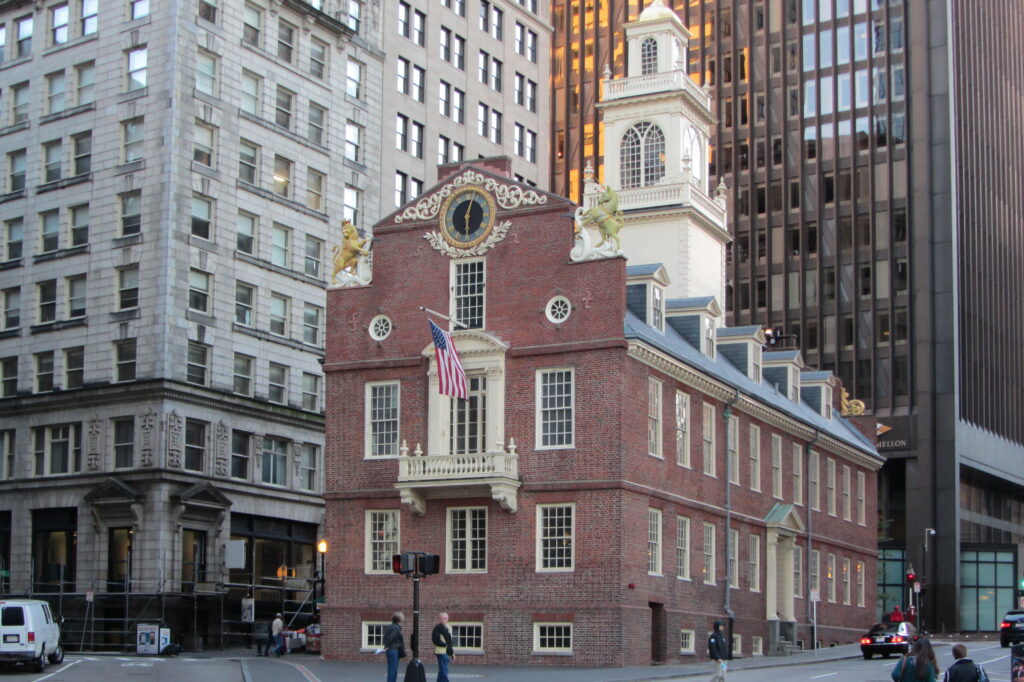
Construida en 1713, la Old State House es el edificio público más antiguo que se conserva en Boston. Era el centro de la vida política y comercial, albergando la bolsa de comerciantes (un precursor de la bolsa de valores actual) en la planta baja y las oficinas gubernamentales designadas por la realeza y los miembros libremente elegidos de la Asamblea de la Colonia de la Bahía de Massachusetts en los pisos superiores.
El sitio jugó un papel central en la historia de la rebelión, desde el discurso de James Otis de 1761 contra las órdenes de asistencia a la masacre de Boston en 1770 hasta la lectura de la Declaración de Independencia desde el balcón este en julio de 1776.
SITIO DE LA MASACRE DE BOSTON
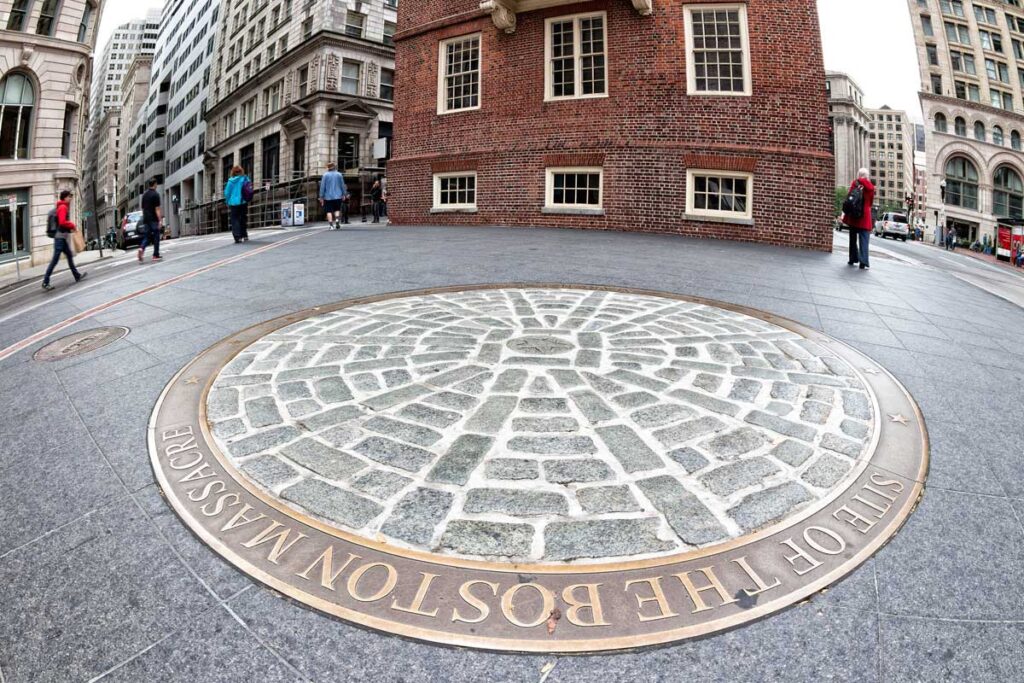
Junto a la Old State House, un anillo de adoquines conmemora la masacre de Boston. Cinco hombres murieron en este enfrentamiento entre colonos y casacas rojas. Entre los hombres asesinados se encontraba Crispus Attucks, el primer afroamericano que murió por la causa patriótica.
Curiosamente, John Adams y Josiah Quincy, leales tanto a la justicia como a la causa patriótica, defendieron a los soldados británicos. Todos menos dos fueron absueltos. A los culpables les marcaron los pulgares y luego los dejaron en libertad.
SALA FANEUIL
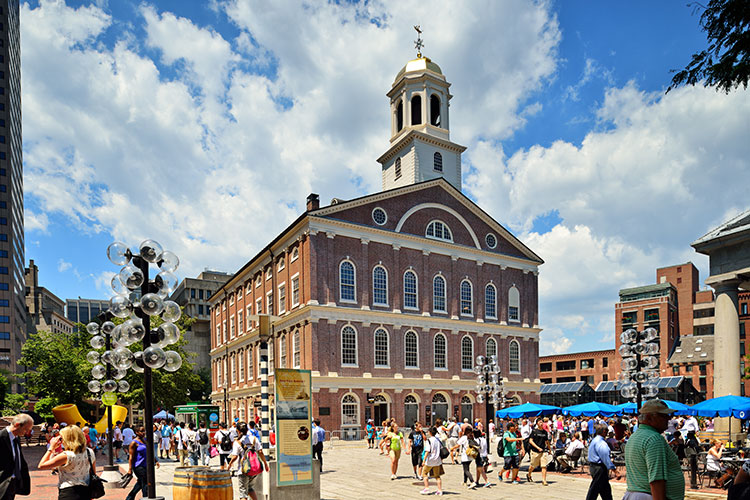
El edificio fue un regalo del rico comerciante Peter Faneuil en 1742. Faneuil Hall sirvió como lugar de reunión y mercado al aire libre. Fue aquí donde los bostonianos se reunieron para formar su oposición a la autoridad británica. Como resultado de los apasionados discursos de patriotas como Samuel Adams y James Otis, se ganó el apodo de Cuna de la Libertad, especialmente cuando los ciudadanos se manifestaron contra la Ley del Azúcar, la Ley del Timbre, las Leyes Townsend y el desembarco de tropas británicas.
Charles Bulfinch amplió el edificio en 1806. Después de la Revolución, los bostonianos continuaron reuniéndose en Faneuil Hall para los discursos contra la esclavitud de William Lloyd Garrison, Wendell Phillips y Frederick Douglass. Dentro de estos muros se han debatido el movimiento por los derechos de las mujeres, las primeras manifestaciones por la templanza y casi todas las guerras desde 1812.
CASA PAUL REVERE
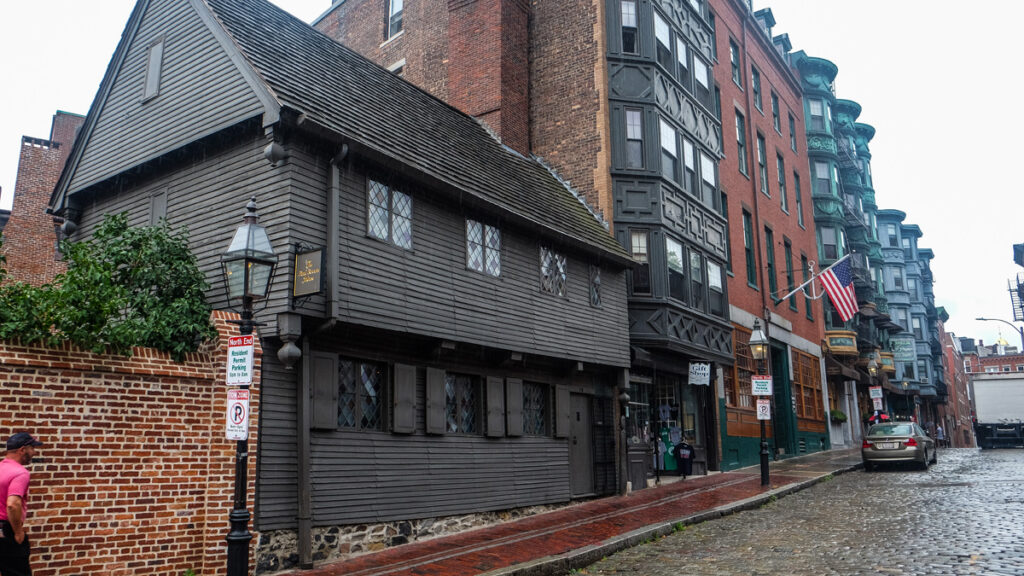
Construida alrededor de 1680, la Casa Paul Revere es la estructura más antigua que queda en el centro de Boston y el único sitio oficial de Freedom Trail que es un hogar. Desde aquí partió su famoso ocupante para el paseo de medianoche. Revere no sólo era un patriota, sino también un experto platero, fabricante de cobre, dentista a tiempo parcial, grabador y padre de 16 hijos. Aquí vivieron con él hasta ocho hijos, junto con su madre, su primera y (después de 1773) su segunda esposa.
IGLESIA ANTIGUA DEL NORTE
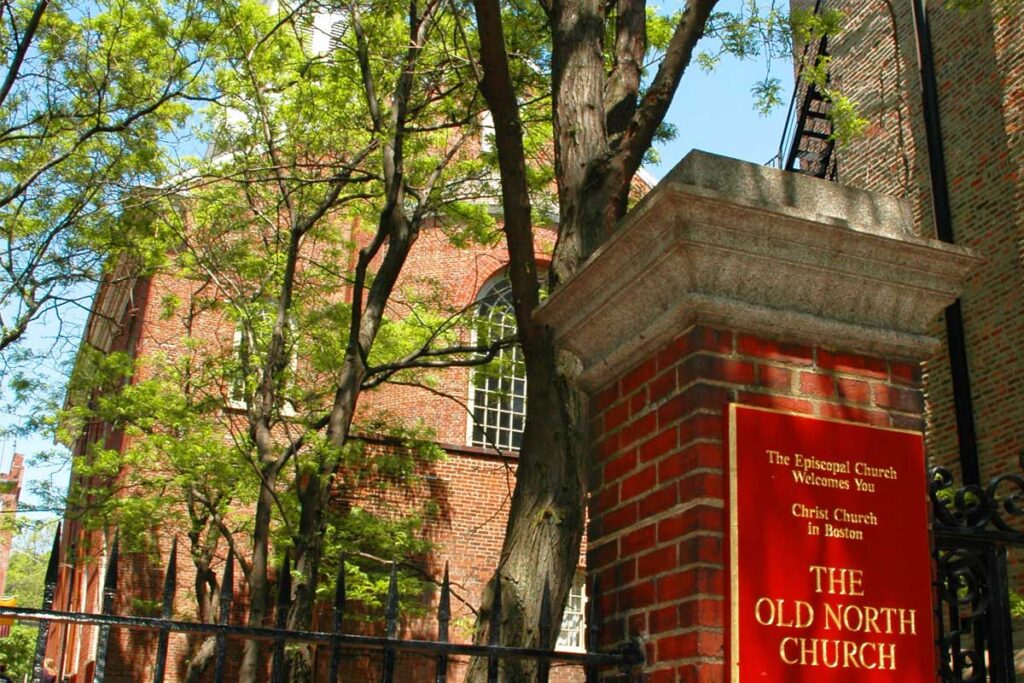
Fue desde este campanario desde donde el sacristán Robert Newman colgó dos faroles el 18 de abril de 1775, para señalar el comienzo del trascendental viaje de Paul Revere. La acción es ampliamente considerada como la chispa que encendió la Revolución Americana.
Construida en 1723, Old North es la iglesia más antigua de Boston. Vea una gran cantidad de obras históricas, incluidas las primeras campanas traídas a las colonias, sus candelabros y relojes de latón originales del siglo XVIII y los ángeles tallados del siglo XVII que fueron capturados por un corsario colonial. Más de 1.000 personas yacían descansando en la cripta subterránea, incluido el segundo al mando del Gobernador Real en Lexington y Concord.
CEMENTERIO DEL CERRO DEL COPP
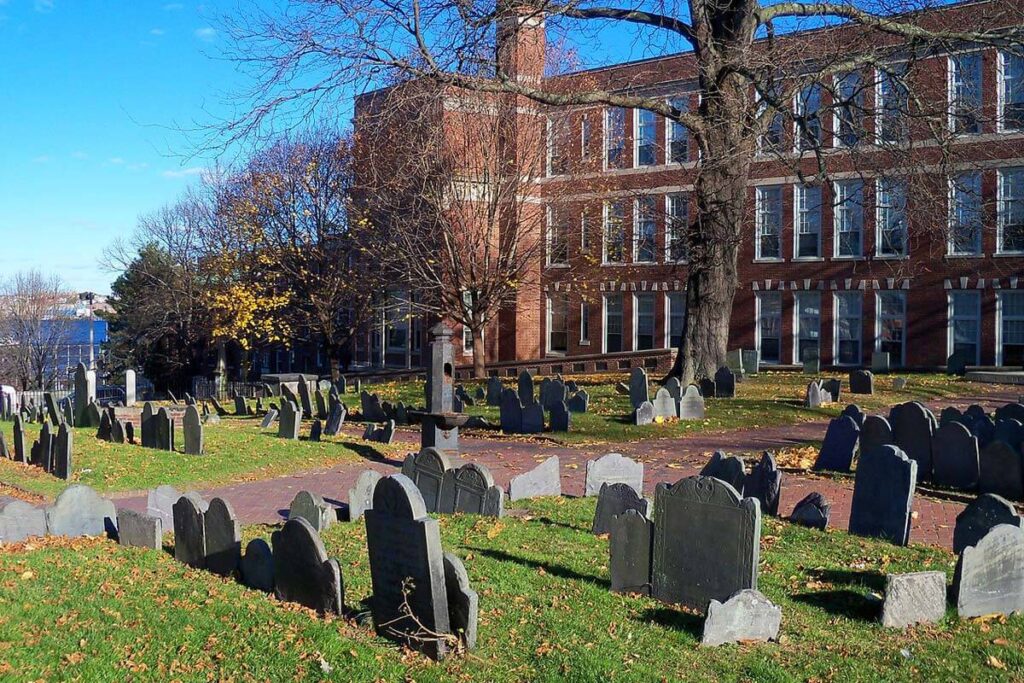
Copp’s Hill fue el cementerio colonial más grande de Boston, que data de 1659. Algunos personajes notables enterrados aquí incluyen la familia Mather, una familia ministerial muy prominente de Nueva Inglaterra; Edmund Hartt, constructor de la Constitución del USS; Robert Newman, quien colgó las linternas para el viaje de Paul Revere, y Prince Hall, activista contra la esclavitud, soldado revolucionario y fundador de la Gran Logia Masónica Africana. Copp’s Hill es también el lugar de descanso final de innumerables afroamericanos libres.
Debido a su altura y ubicación destacada con vistas al puerto de Boston, los británicos utilizaron el cementerio para apuntar sus cañones a Charlestown durante la batalla de Bunker Hill. Aquí también se realizaron prácticas de tiro. Asegúrese de echar un vistazo a la lápida de Daniel Malcom, miembro de los Hijos de la Libertad.
USS CONSTITUTION
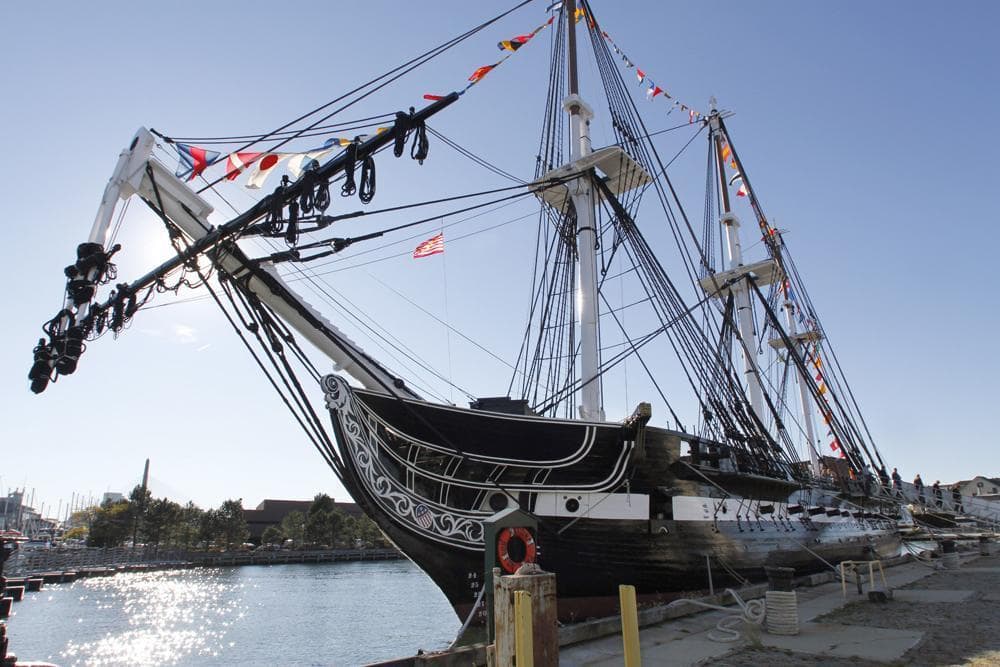
Botado en Boston en 1797, el USS Constitution es el buque de guerra encargado más antiguo del mundo. Su apodo se ganó durante la Guerra de 1812, cuando las balas de cañón británicas parecieron rebotar en su impenetrable casco y los marineros gritaron ¡Hurra! ¡Sus costados están hechos de hierro! Hoy en día está tripulado por una tripulación de la Marina de los EE. UU. en servicio activo y está atracado en el astillero de la Marina de Charlestown.
MONUMENTO DE LA COLINA DEL BÚNKER
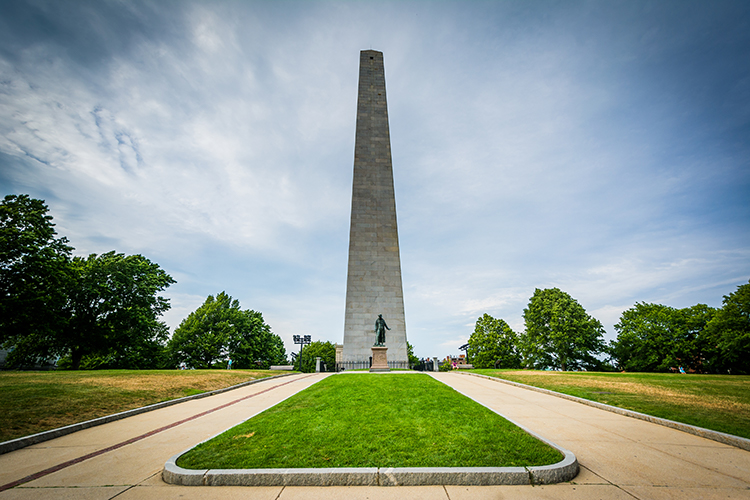
La Batalla de Bunker Hill fue una de las batallas más sangrientas de la Revolución Americana. “¡No dispares hasta que veas el blanco de sus ojos!” se convirtió en el legendario grito de batalla, según la tradición, e inmortalizó la determinación de los colonos mal equipados que se enfrentaron al poderoso ejército británico el 17 de junio de 1775. Hoy, el obelisco de granito de 221 pies conmemora el lugar de esta primera gran batalla.
English version
The Freedom Trail: A Walk Through America’s History
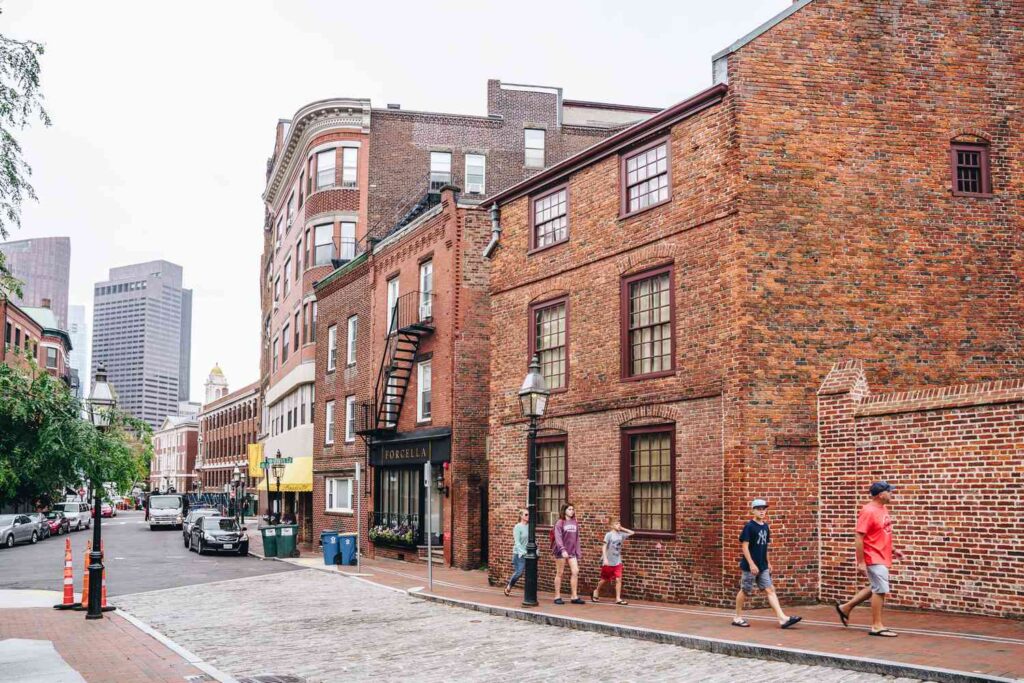
The famous Freedom Trail is a 2.5-mile red-brick trail through Boston’s historic neighborhoods that tells the story of the American Revolution and beyond. From the Old North Church to Faneuil Hall, and through resonant burying grounds, visit the temples and landmarks of the Revolutionary Era.
Freedom Trail Sites
Begin your journey at the Boston Common Visitor Information Center located at 139 Tremont Street and conclude at the USS Constitution in Charlestown.
BOSTON COMMON
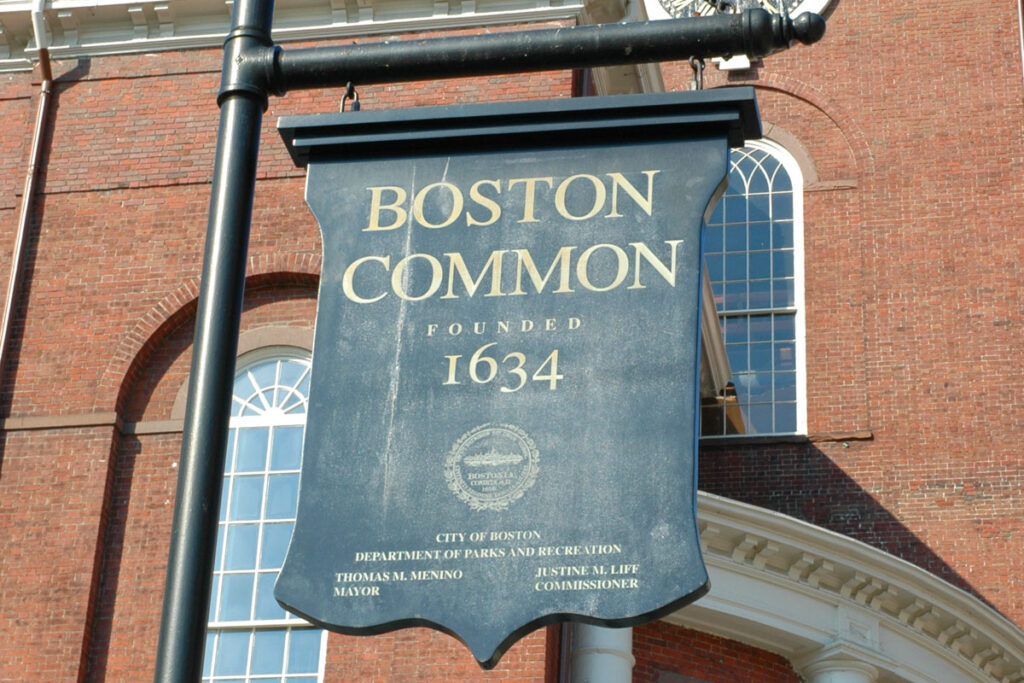
The Boston Common is America’s oldest public park, purchased from Wm. Blackstone in 1635 to be used as common grazing land for the feeding of cattell. The British militia used it as a trayning field.
The Common has also been the site of hangings, duels, public celebrations and spirited oratory. Today it continues to host public celebrations as well as concerts, ice skating, Shakespearean plays, holiday festivities, sports activities and public rallies.
MASSACHUSETTS STATE HOUSE
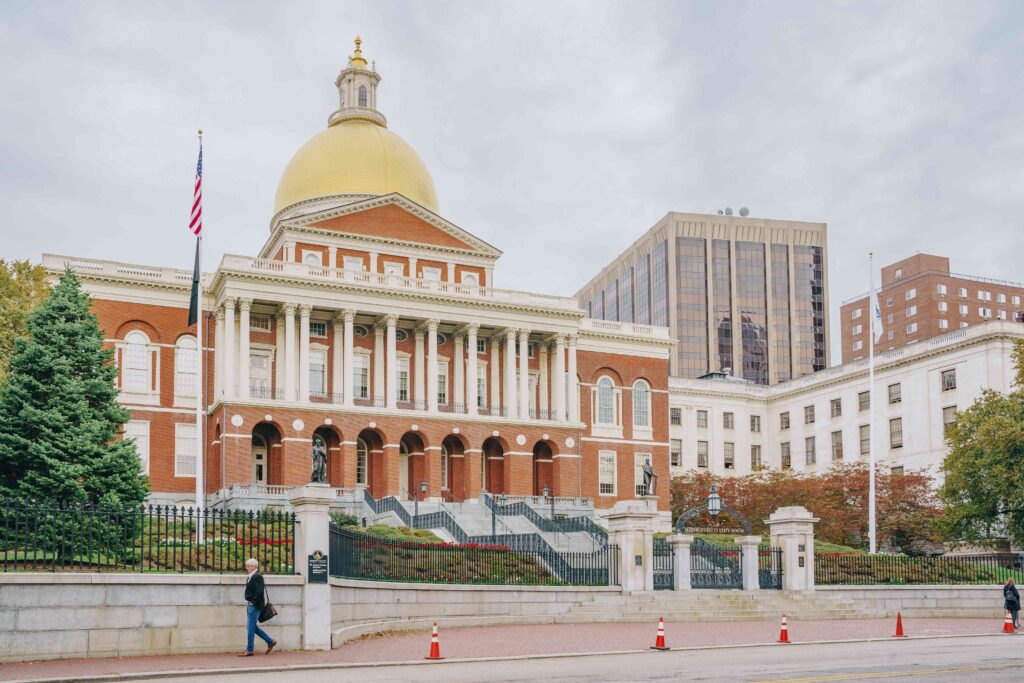
Designed by Charles Bulfinch, the State House was completed in January 1798 at a cost of $133,333 (more than five times the budget). John Hancock, a wealthy merchant, patriot, signer of the Declaration of Independence and the first elected Governor of Massachusetts originally owned the land. The oldest building on Beacon Hill is now the seat of the Massachusetts state government. The golden dome, one of Boston’s distinguishing landmarks, wasn’t always gilded. It was originally built of wood. Paul Revere & Sons was commissioned in 1802 to cover it with copper to prevent water leakage. In 1874, the dome was gilded with 23-karat gold leaf.
PARK STREET CHURCH
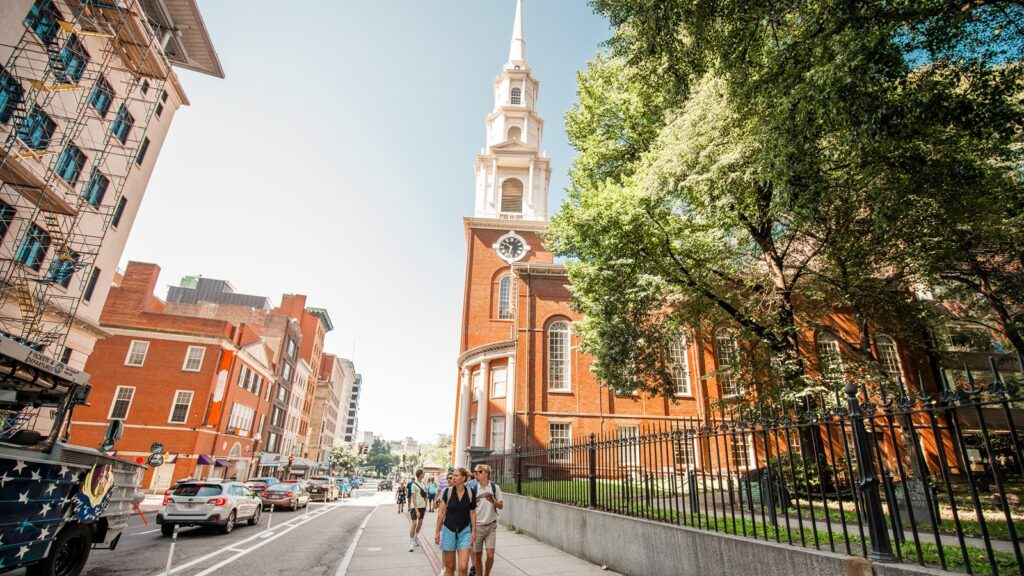
Park Street Church acquired the nickname Brimstone Corner, both in reference to the fire-and-brimstone sermons and to the gun powder that was stored in the crypt during the War of 1812. Founded in 1809, the Church’s 217-foot white steeple was the first landmark a traveler saw upon approaching Boston.
On July 4, 1829, abolitionist William Lloyd Garrison gave his first public anti-slavery address here, and two years later, on July 4, the hymn America, better known as My Country ’Tis of Thee, was first sung on the Church steps.
GRANARY BURYING GROUND
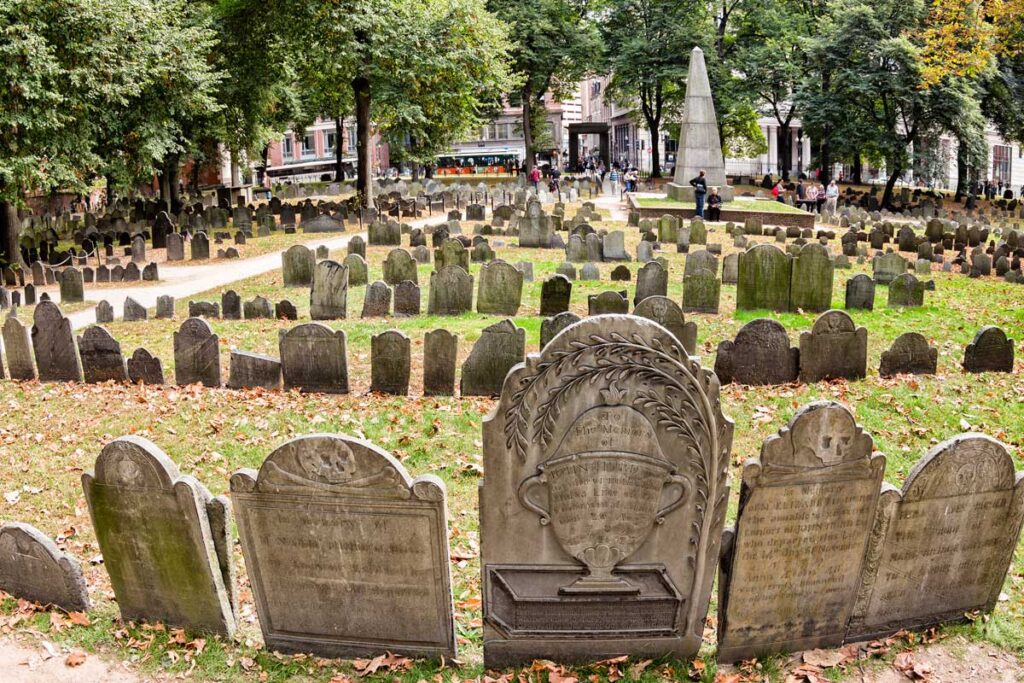
So named because of its proximity to Boston’s first granary, this is the most visited burying ground in Boston and the final resting place of many prominent Bostonians. Buried here are John Hancock, Samuel Adams, nine governors, all five Boston Massacre victims, Paul Revere, Ben Franklin’s parents and Peter Faneuil.
KING’S CHAPEL & BURYING GROUND
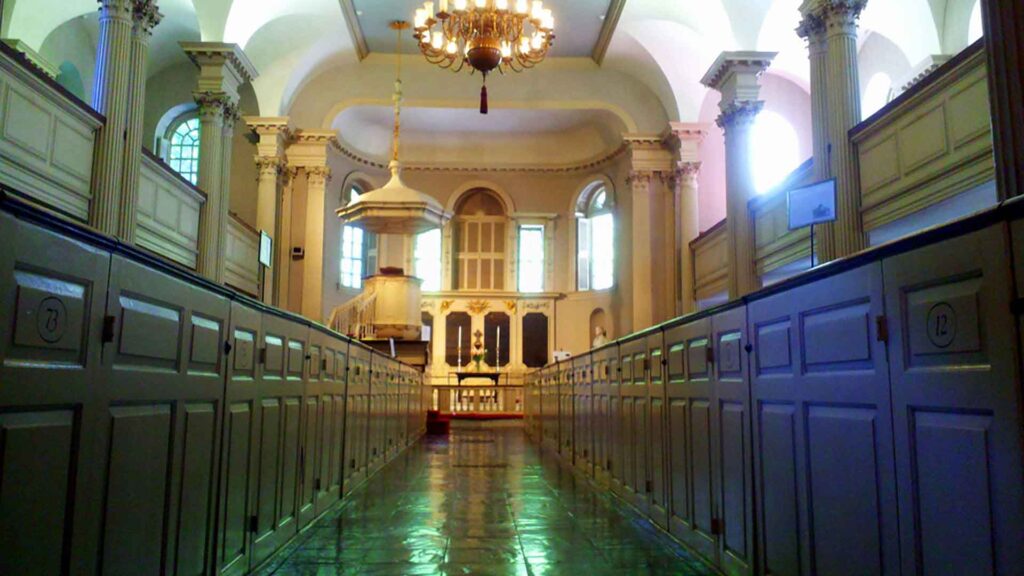
Under orders from King James II in 1686, land was seized, and the first Anglican Church was constructed. By 1749, the original wooden structure was too small for the congregation, and so the Georgian chapel was constructed around the original church.
Adjacent to King’s Chapel is Boston’s first burying ground. Here you will find the graves of John Winthrop, Massachusetts’ first governor; William Dawes, Paul Revere’s compatriot who also made the ride to Lexington, and Mary Chilton, believed to be the first woman to step off the Mayflower.
BOSTON LATIN SCHOOL SITE/BENJAMIN FRANKLIN STATUE
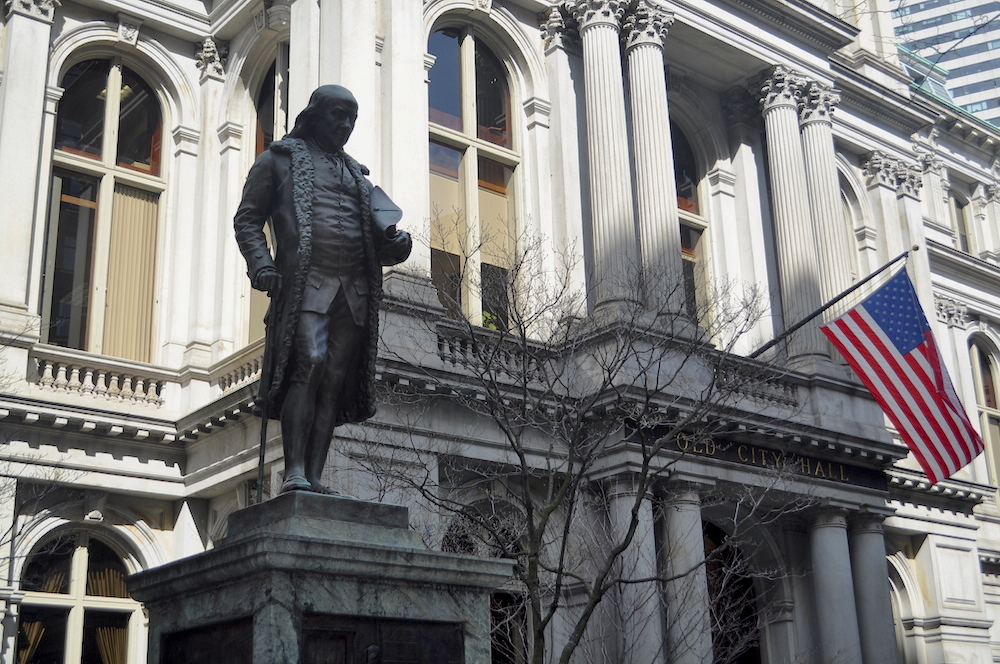
Embedded in the sidewalk in front of Old City Hall is the mosaic City Carpet, which commemorates the site of the first public school in the U.S., Boston Latin School (1635). Among the school’s alumni are Ben Franklin, John Hancock, Samuel Adams, Charles Bulfinch and Ralph Waldo Emerson.
Richard Greenough’s statue of Ben Franklin, erected in 1856, prominently stands in front of Old City Hall. Look closely at Franklin’s face. The sculptor said that he found the left side of the great man’s face philosophical and reflective and the right side funny and smiling.
OLD CORNER BOOKSTORE
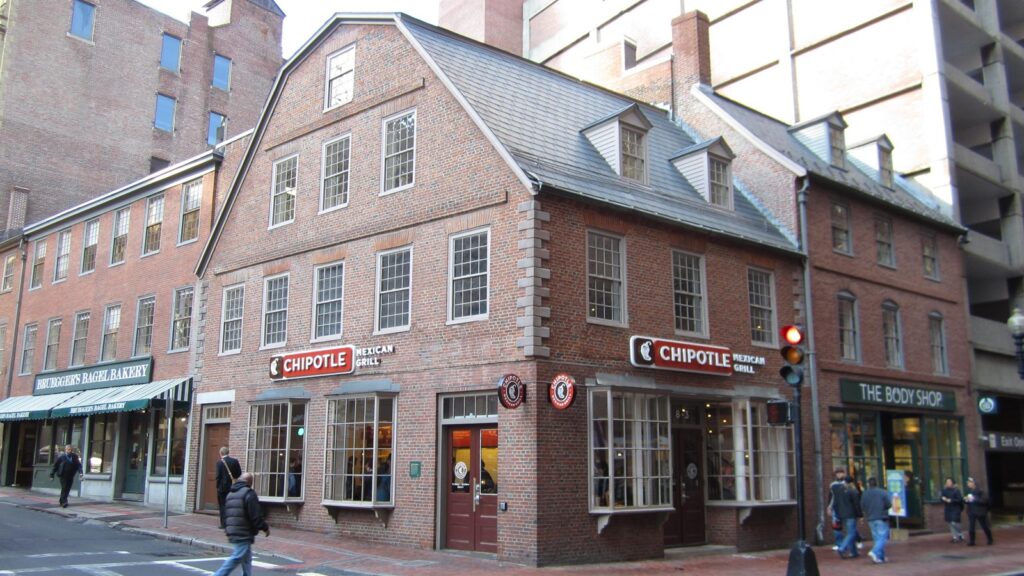
The original building on this site was the home of Anne Hutchinson, who was banished from Massachusetts in 1638 for her unorthodox religious views. By the mid-1800s, the Old Corner Bookstore was a flourishing literary center. Here, Ticknor and Fields published works by Dickens, Harriet Beecher Stowe, Tennyson, Hawthorne, Emerson, Longfellow, Oliver Wendell Holmes, Elizabeth Barrett Browning and Julia Ward Howe among others. The Atlantic Monthly, a Boston institution, was originally published here as well. Today, the building continues as a place of commerce.
OLD SOUTH MEETING HOUSE
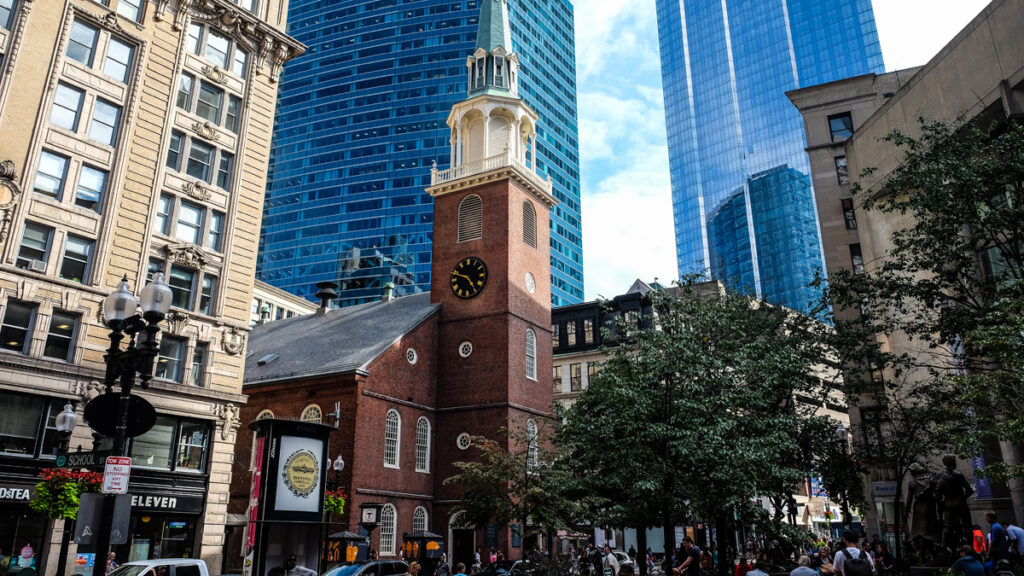
Built in 1729, this is the second oldest church in Boston. The largest building in colonial Boston, Old South was used for public meetings when the angry crowd outgrew Faneuil Hall. Many of the crucial events that led up to the Revolution took place here. The most famous of the meetings was held on December 16, 1773, when over 5,000 gathered to protest the tax on tea.
During the British occupation of Boston in 1775-1776, British troops desecrated this sanctuary of freedom by using it as a stable and riding school, while drinks were served from the balcony. The pulpit and pews were chopped into firewood and the library was used as kindling.
On another note, Phillis Wheatley, the first female African American published poet, was a full member of the Meeting House. An original copy of her work is on permanent display here.
OLD STATE HOUSE MUSEUM
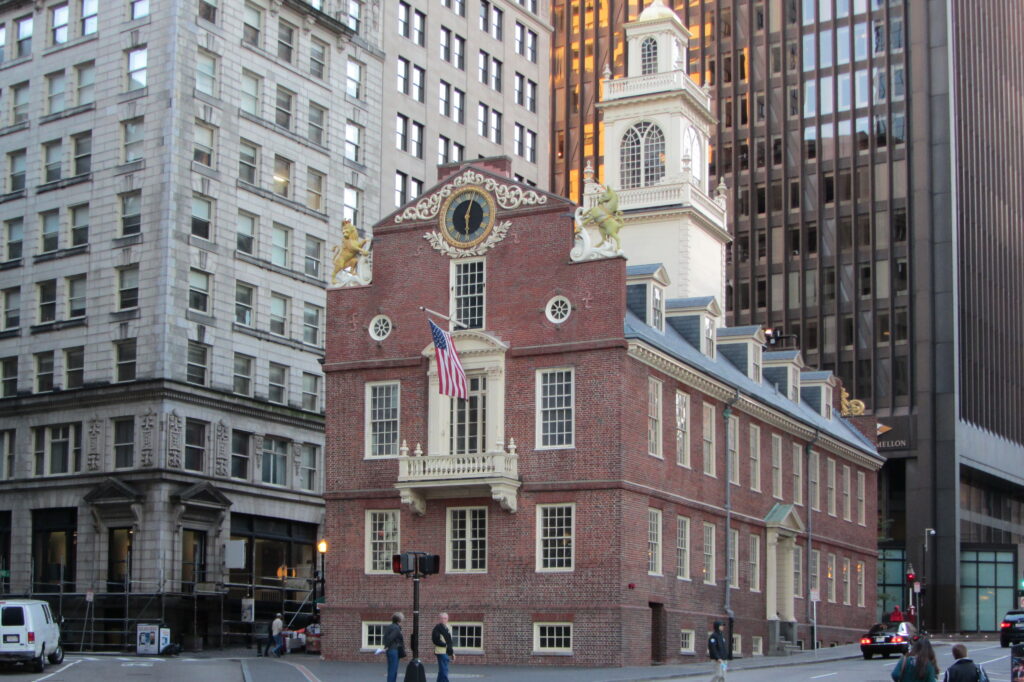
Built in 1713, the Old State House is Boston’s oldest surviving public building. It was the center of political and commercial life, housing the merchant’s exchange (a precursor to today’s stock exchange) on the ground floor and the royally appointed government offices and the freely elected members of the Assembly of the Massachusetts Bay Colony on the upper floors.
The site played a central role in the story of rebellion, from James Otis’ 1761 speech against the Writs of Assistance to the Boston Massacre in 1770 to the reading of the Declaration of Independence from the east balcony in July 1776.
BOSTON MASSACRE SITE
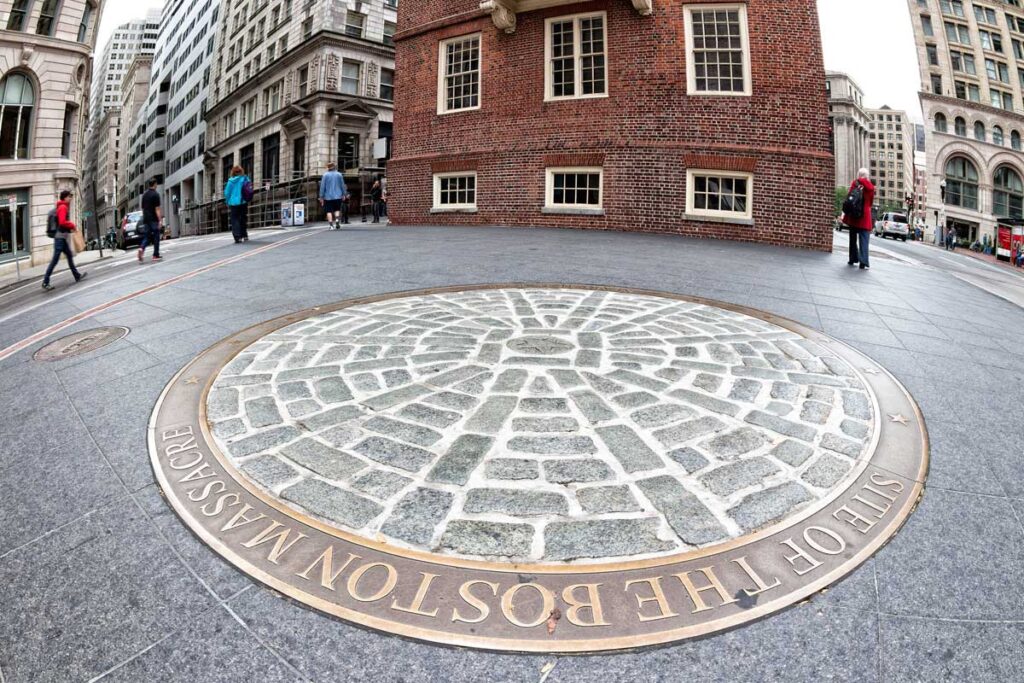
Adjacent to the Old State House, a ring of cobblestones commemorates the Boston Massacre. Five men were killed in this clash between Colonists and Redcoats. Among the slain men was Crispus Attucks, the first African American to die for the patriotic cause.
Interestingly, John Adams and Josiah Quincy, loyal to justice as well as the patriotic cause, defended the British soldiers. All but two were acquitted. The guilty had their thumbs branded and were then set free.
FANEUIL HALL
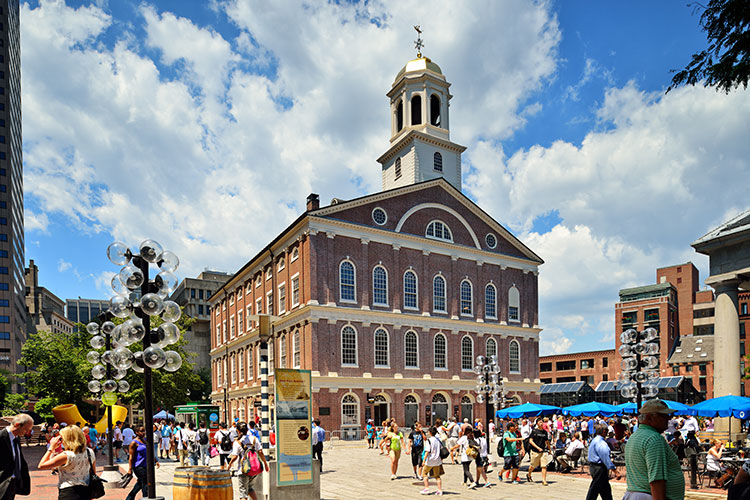
The building was a gift from wealthy merchant Peter Faneuil in 1742. Faneuil Hall served as a meeting place and an open-air market. It was here that Bostonians met to form their opposition to British authority. As a result of the impassioned speeches by such patriots as Samuel Adams and James Otis, the nickname Cradle of Liberty was earned, especially when citizens rallied against the Sugar Act, the Stamp Act, the Townsend Acts and the landing of British troops.
Charles Bulfinch enlarged the building in 1806. After the Revolution, Bostonians continued to gather at Faneuil Hall for the anti-slavery speeches of William Lloyd Garrison, Wendell Phillips and Frederick Douglass. The women’s rights movement, early temperance rallies and nearly every war since 1812 have been debated within these walls.
PAUL REVERE HOUSE
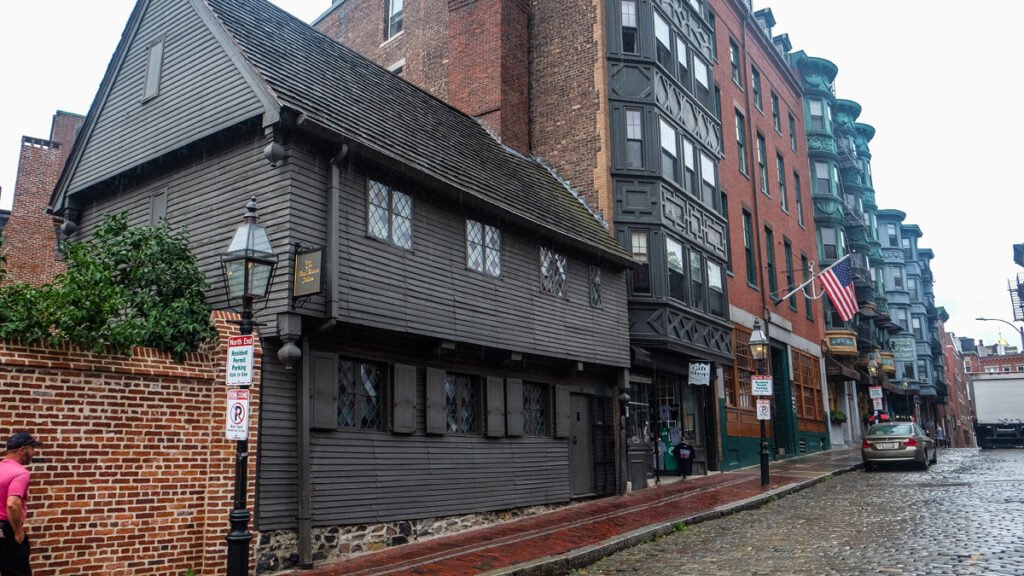
Built around 1680, the Paul Revere House is the oldest remaining structure in downtown Boston, and only official Freedom Trail site that is a home. It was from here that its famous occupant set out for the midnight ride. Revere was not only a patriot, but also an expert silversmith, copper manufacturer, part-time dentist, engraver and the father of 16 children. As many as eight children lived here with him, along with his mother, his first and (after 1773) his second wife.
OLD NORTH CHURCH
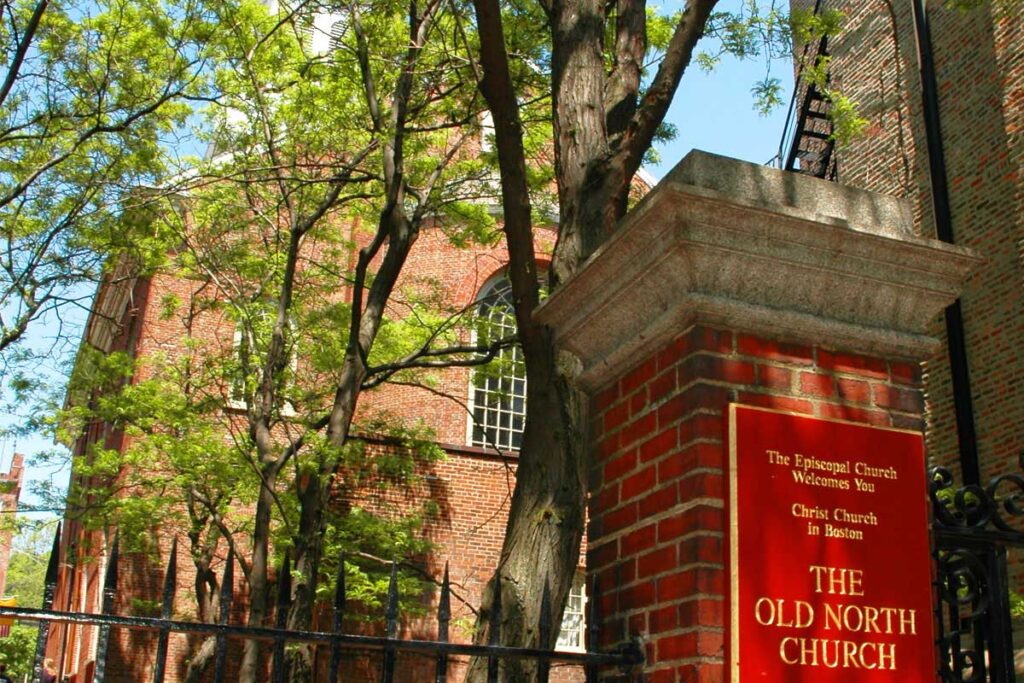
It was from this steeple that Sexton Robert Newman hung two lanterns on April 18, 1775, to signal the beginning of Paul Revere’s momentous ride. The action is widely regarded as the spark that ignited the American Revolution.
Built in 1723, Old North is Boston’s oldest church building. See a wealth of historic works, including the first bells brought to the Colonies, its original 18th-century brass chandeliers and clock, and the 17th- century carved angels that were captured by a Colonial privateer. More than 1,000 individuals lay in rest in the underground crypt, including the Royal Governor’s second-in-command at Lexington and Concord.
COPP’S HILL BURYING GROUND
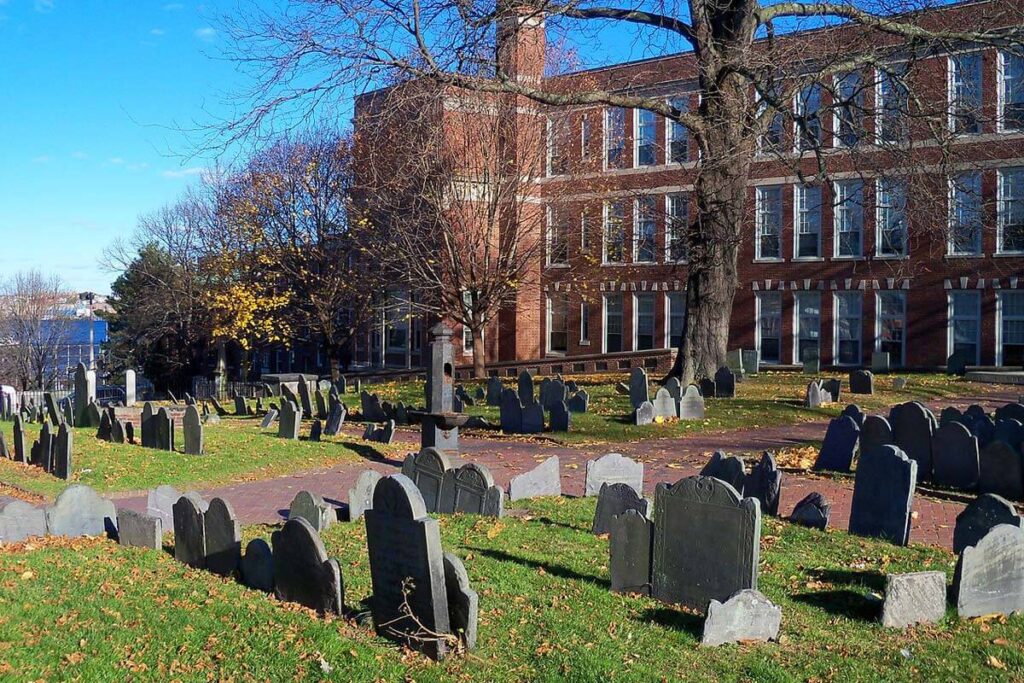
Copp’s Hill was Boston’s largest colonial burying ground, dating from 1659. Some notables buried here include the Mather family, a very prominent New England ministerial family; Edmund Hartt, builder of the USS Constitution; Robert Newman, who hung the lanterns for Paul Revere’s ride, and Prince Hall, anti-slavery activist, Revolutionary soldier and founder of the African Grande Masonic Lodge. Copp’s Hill is also the final resting place of countless free African Americans.
Because of its height and prominent location overlooking Boston Harbor, the British used the burying ground to aim their cannons on Charlestown during the Battle of Bunker Hill. Target practice was also conducted here. Be sure to take a look at the grave marker of Daniel Malcom, a member of the Sons of Liberty.
USS CONSTITUTION – OLD IRONSIDES
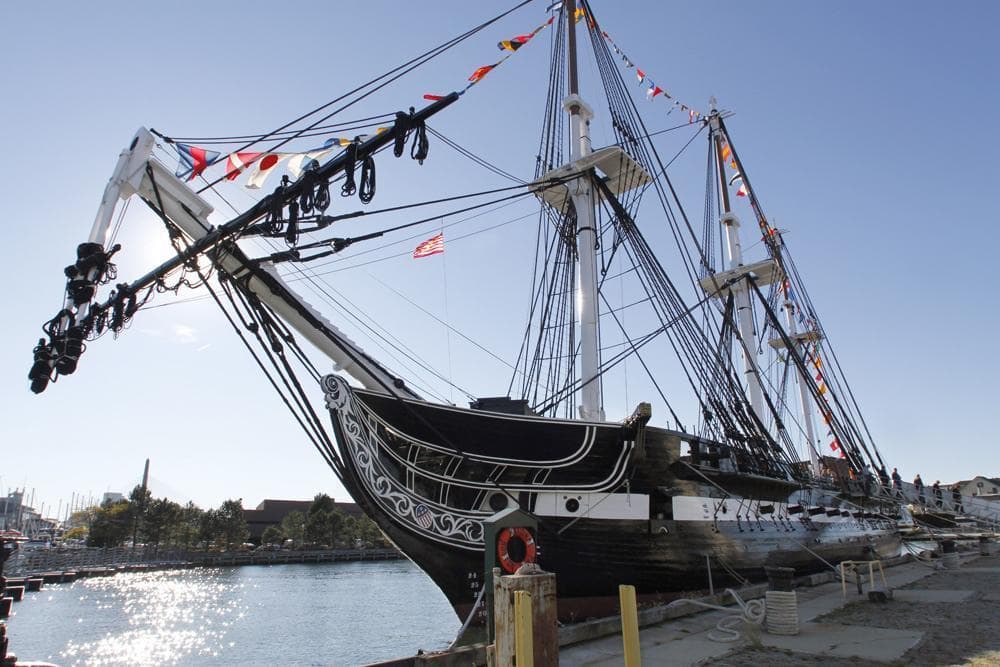
Launched in Boston in 1797, the USS Constitution is the oldest commissioned warship afloat in the world. Her nickname was earned during the War of 1812 when British cannonballs appeared to bounce off her impenetrable hull and the seamen cried out Huzzah! Her sides are made of iron! Today she is manned by an active duty U.S. Navy crew and docked in the Charlestown Navy Yard.
BUNKER HILL MONUMENT
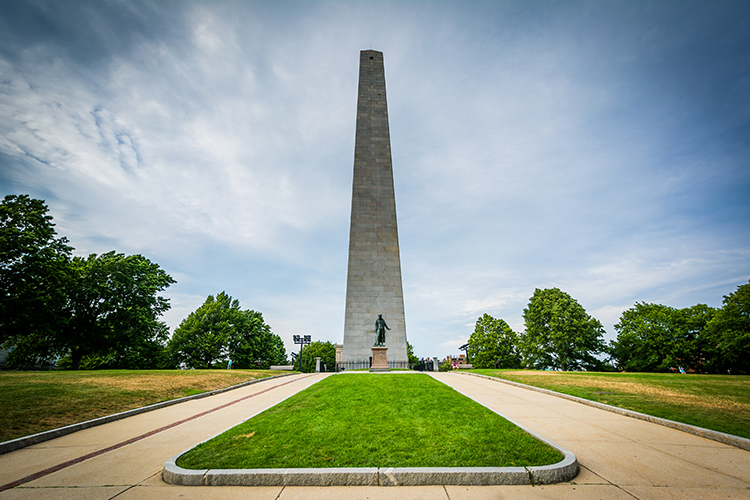
The Battle of Bunker Hill was one of the bloodiest battles of the American Revolution. “Don’t fire until you see the whites of their eyes!” became the legendary battle cry, according to lore, and immortalized the determination of the ill-equipped Colonists who stood facing the powerful British Army on June 17, 1775. Today the 221-foot granite obelisk commemorates the site of this first major battle.

